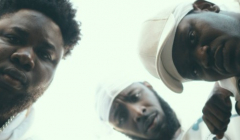
CALM and T&Pm lean on drill music to break mental health taboos
The creatively bold campaign utilises comedy to help create the space for Generation Z to talk about their mental health.

How the merging of the two industries is mutually beneficial

The coming together of football and fashion is nothing new. Brands like Sergio Tacchini and Stone Island were at the centre of 80’s casual culture in England, whilst David Beckham’s tie-ups with the likes of Police and Armani in the early 00’s heralded a new era of footballers being seen as fashion icons. This then paved the way for the likes of Cristiano Ronaldo and Leo Messi to extend their influence beyond football and into mainstream culture, culminating in the launch of their own lifestyle brands in the 10’s.
Today’s football icons are more multifaceted; simultaneously athletes, activists, and influencers. This has allowed them to build wide and deeply engaged fan-bases, which makes them far more appealing to brands in a world where authenticity is king. As a result, partnerships with fashion labels are no longer the preserve of a handful of globally recognisable names.
The appeal and awareness of footballers increasingly extends beyond traditional match-going fans
Ryan Deluchi, Global partnerships director, COPA90
Marcus Rashford has become the face of Burberry - not for how he looks in underwear, but for his involvement in UK politics.
Jack Grealish - a mercurial talent but unlikely to be a Ballon D’Or contender any time soon - is now a Gucci ambassador.
Eduardo Camavinga recently became the first footballer to walk for Balenciaga, alongside Dua Lipa and Naomi Campbell. A French international, but hardly a household name yet.
A cursory scroll through Footballer Fits - an online platform with over 550,000 followers that aims to ‘eradicate football’s mindset that athletes are one-dimensional’ - quickly throws up the likes of Dele Alli in Louis Vuitton, Michy Batshuayi in Loewe, and Trevor Chalobah in Prada.
Whilst all of these players represent elite teams (yes, Manchester United still count), none of them have that stratospheric global appeal that the likes of Beckham and Ronaldo enjoyed, suggesting a marked shift in how fashion brands are identifying ambassadors within the game; a search for substance as well as style.
What’s more, as the appeal and awareness of footballers increasingly extends beyond traditional match-going fans and the definition of what even constitutes a football fan becomes blurred, brands are seeing an opportunity to connect with sizable new audiences in surprising ways. It’s unlikely that Kylian Mbappe would have been on LVMH’s radar a few years ago, but as the embodiment of Parisian Gen Z street culture he now represents a chance to gain relevance with a young, aspirational audience - highly valuable to a brand that trades on Franco-cool.
This idea of leaning into local creative culture isn’t lost on clubs either. Chelsea FC and COPA90’s Club Culture initiative - a celebration of football, fashion and music fusion in London - is a prime example of how teams are also recognising the role that creativity plays in the lives of modern fans.
But perhaps fashion’s influence on the football industry is being most felt in the women’s game right now.
England’s Lionesses appearing in Elle and Vogue ahead of the European Championships were important moments in changing the perception of female footballers in the lead up to the tournament, whilst Leah Williamson being invited to the Gucci Cosmonogie show in Puglia is an example of the kind of glamour and edge that the men’s game has benefitted from for decades.
Meanwhile in the US, Gotham FC are seamlessly weaving catwalk culture into their social content to win new fans, whilst Angel City FC have Birdies and Rachel Zoe’s luxury lifestyle brand Curateur on board as brand partners. Both teams’ associations with fashion culture will help them grow their fan bases and unlock new commercial opportunities that will be crucial to their long-term success.
Football is no longer an isolated part of culture; it sits at the heart of it, influencing and being influenced by fashion and other cultural forces such as music and gaming. With both the Men’s and Women’s World Cup scheduled in the next 12 months, there has never been a better time for fashion brands to get involved in the beautiful game.
Ryan is Global Partnerships Director at COPA90 – the fan-first football media company - helping brands engage meaningfully with football fans all over the world. After cutting his teeth in the advertising industry at the likes of TBWA and Grey, Ryan moved to You & Mr Jones’ global content network, Mofilm, heading up their UK office and overseeing their integration with in-housing expert, Oliver. Most recently he was MD of Gen Z research and insight platform SELFHOOD, building a community of young voices around the world to inform brand decision making. Ryan is a firm believer in the power of community-led models to help marketers avoid echo chambers and build better, more relevant brands as a result.
Looks like you need to create a Creativebrief account to perform this action.
Create account Sign inLooks like you need to create a Creativebrief account to perform this action.
Create account Sign in